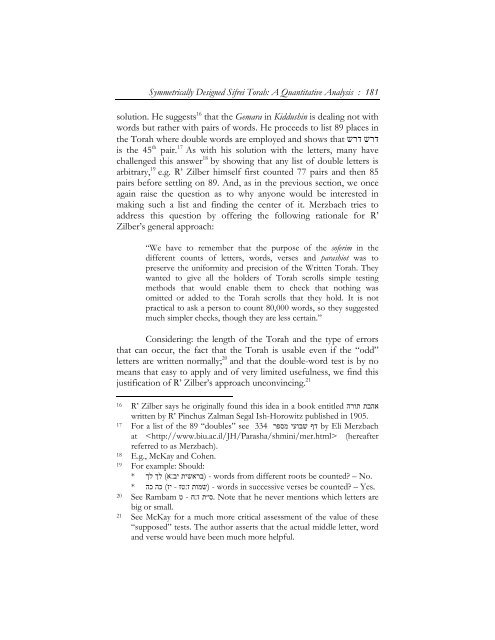Symmetrically Designed Sifrei Torah: A Quantitative Analysis - Hakirah
Symmetrically Designed Sifrei Torah: A Quantitative Analysis - Hakirah
Symmetrically Designed Sifrei Torah: A Quantitative Analysis - Hakirah
You also want an ePaper? Increase the reach of your titles
YUMPU automatically turns print PDFs into web optimized ePapers that Google loves.
<strong>Symmetrically</strong> <strong>Designed</strong> <strong>Sifrei</strong> <strong>Torah</strong>: A <strong>Quantitative</strong> <strong>Analysis</strong> : 181<br />
solution. He suggests 16 that the Gemara in Kiddushin is dealing not with<br />
words but rather with pairs of words. He proceeds to list 89 places in<br />
דרש דרש the <strong>Torah</strong> where double words are employed and shows that<br />
is the 45 th pair. 17 As with his solution with the letters, many have<br />
challenged this answer 18 by showing that any list of double letters is<br />
arbitrary, 19 e.g. R’ Zilber himself first counted 77 pairs and then 85<br />
pairs before settling on 89. And, as in the previous section, we once<br />
again raise the question as to why anyone would be interested in<br />
making such a list and finding the center of it. Merzbach tries to<br />
address this question by offering the following rationale for R’<br />
Zilber’s general approach:<br />
“We have to remember that the purpose of the soferim in the<br />
different counts of letters, words, verses and parashiot was to<br />
preserve the uniformity and precision of the Written <strong>Torah</strong>. They<br />
wanted to give all the holders of <strong>Torah</strong> scrolls simple testing<br />
methods that would enable them to check that nothing was<br />
omitted or added to the <strong>Torah</strong> scrolls that they hold. It is not<br />
practical to ask a person to count 80,000 words, so they suggested<br />
much simpler checks, though they are less certain.”<br />
Considering: the length of the <strong>Torah</strong> and the type of errors<br />
that can occur, the fact that the <strong>Torah</strong> is usable even if the “odd”<br />
letters are written normally; 20 and that the double-word test is by no<br />
means that easy to apply and of very limited usefulness, we find this<br />
justification of R’ Zilber’s approach unconvincing. 21<br />
אהבת תורה 16 R’ Zilber says he originally found this idea in a book entitled<br />
written by R’ Pinchus Zalman Segal Ish-Horowitz published in 1905.<br />
17 For a list of the 89 “doubles” דף שבועי מספר see 334 by Eli Merzbach<br />
at (hereafter<br />
referred to as Merzbach).<br />
18 E.g., McKay and Cohen.<br />
19 For example: Should:<br />
) - words from different roots be counted? – No.<br />
Yes. - words in successive verses be counted? – (שמות ז׃טז - יז) כה כה *<br />
20 See Rambam ז׃ח - ט .ס״ת Note that he never mentions which letters are<br />
big or small.<br />
21 See McKay for a much more critical assessment of the value of these<br />
“supposed” tests. The author asserts that the actual middle letter, word<br />
and verse would have been much more helpful.<br />
ברא שית יב׃א) לך לך *
















